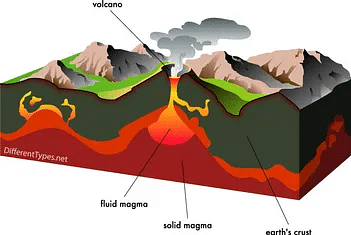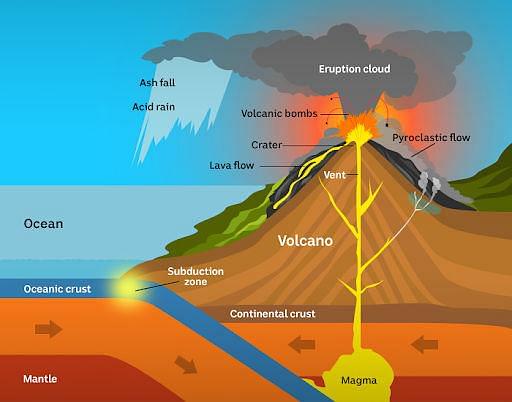Collegedunia Team Content Curator
Content Curator
Magma and lava differ by their location. When geologists refer to magma, they are referring to molten rock that is trapped underground. When this molten rock rises and continues to flow like a liquid, it is called lava. Magma and lava are terms associated with volcanoes and volcanic eruptions. Volcanoes are pressure-driven and act as openings through which gases, magma and volcanic ashes escape.
| Table of Content |
Key takeaways: Lava, Magma, Crust, Rhyolitic, Volcano
Magma
[Click Here for Sample Questions]
Magma is the source of igneous rocks. It usually melts or melts slightly over a period. However, the main distinguishing feature of magma is that it is found underground. It is a piece of the mantle that has escaped through the cracks in the earth's crust. It is a plastic container where tectonic plates float and move.

Layers of Earth
Magma is also a storehouse of precious crystals and gas bubbles. These gases contain highly toxic gases, and if inhaled, they can also prove fatal. When magma escapes the earth from volcanoes, these gases and lava flows can cause immeasurable damage to society and civilization. Volcanoes, on the other hand, are also the source of life-sustaining minerals and nutrients brought to the ground as a result of volcanic eruptions.
Read More:
| Related Articles | ||
|---|---|---|
| Role of Atmosphere in Climate Control | Ozone Layer Depletion | Ozone |
Types of Magma
[Click Here for Sample Questions]
Magma is formed of minerals and therefore, there are three types of magma:
- Basaltic from bottom coat/ topcoat. It consists of molten rock enriched with iron and magnesium and reduced in silica.
- Rhyolitic come from the ocean floor. It explodes, creating a solid magma called pumice and ashes.
- Andesitic origins are a continental crust. It has clear crystalline stones where the magma explodes and shines quickly on the surface.

Types of Magma
Also Read:
| Related Topics | ||
|---|---|---|
| Sedimentary rocks | Metamorphic rocks | |
Lava
[Click Here for Sample Questions]
Lava is similar to the formation of magma but the factor that makes it different from magma is that it is part of the magma that has been expelled from the earth's surface. The temperature of lava ranges from 800 to 1,200 °C. The word 'lava' is sometimes used for rock-forming after the lava has cooled. Lava is a mixture of silicate minerals such as olivine, amphibole, quartz, mica, feldspar, and pyroxene.

Volcanic Eruption
Lava is found mainly on the surface of the earth, and as a result, it is free to move. The movement of lava on the surface of the earth is described by the term 'lava flow'. It is the result of a process called 'effusive eruption'. A powerful explosion occurs when the mud is continuously removed from the crust and passes into the underground pipe. It is slower and more chaotic than the explosions, in which the mud is expelled at a much faster rate.
Read More:
| Relevant Articles | ||
|---|---|---|
| Colour of Sun | Importance of Air | |
| Layers of the Earth | Living Organisms | |
Types of Lava
[Click Here for Sample Questions]
There are four types of lava:
- Pahoehoe lava is smooth, slightly swaying, or has a wide hummocky surface.
- Aa lava is like a very rough surface, covered with clinkers.
- The block lava is similar to having peaks that cover most of the loose debris, but the pieces have a normal shape.
- Pillow lava is a type of volcanic rock that results in low-viscosity magma like basalt erupting underwater.
Read More: Difference between Gravitation and Gravity
Difference Between Magma and Lava
[Click Here for Sample Questions]
| Magma | Lava |
|---|---|
| Magma is present under the surface of the earth. | Lava is the part of magma that has been expelled to the surface of the earth. |
| Magma is stored in the magma chamber. And, these magma chambers are present inside the crust of the earth | Lava is released during volcanic eruptions. |
| Magma is much hotter than lava. This is because magma is present under the surface of the earth where the pressure and temperature are much higher than the surface. | Lava is cooler than magma because of its exposure to the air present in the atmosphere of the earth. |
| Magma does not flow because of the limited space and high pressure in the magma chambers under the surface. | Lava flows very easily on the surface of the earth and this flow can lead to serious damage to the property and the lives of human beings. |
Also Read:
| Relevant Topics | ||
|---|---|---|
| Layers of the Earth | Volcanic eruption | |
Things to Remember
- Lava has a cooling effect much faster than magma. This results in lava sometimes crystallizing into a glass.
- Magma takes a long time to cool down, as it is found underground which leads to the formation of large crystals.
- Silicon dioxide is present in large quantities in all forms of magma.
- Earth's mantle is solid rock, however, not completely hard.
- The mantle moves slowly and this movement causes earthquakes and volcanic eruptions in the earth.
Read More:
| Related Articles | ||
|---|---|---|
| Weightlessness | Specific Gravity | |
| Gravitational Potential Energy | Non contact force | |
Sample Questions
Ques: How does the magma come out of the magma chamber? [2 marks]
Ans. Magma forms from the melting of half of the mantle rocks. As these soluble rocks rise to the surface, gas cells from the magma emerge from the solution and form bubbles. These blisters increase as they rise and the pressure from these blisters is stronger than the solid rock around them and causes cracks. Magma flows through these structures and reaches the top and flows out as lava.
Ques: Write a short note on magma and lava.[3 marks]
Ans. Magma is a molten or melted, flexible rock found beneath the Earth's surface. This rough or melted rock resides in a magma chamber at the bottom of a volcano or hardened beneath the surface to form an entrance. Magma reaching the top of the volcano officially turns into lava. Lava is a solid, hot, and flowy liquid. Studies show various types of lava depending on their thickness or viscosity.
Ques: Differentiate between crust and mantle. [3 marks]
Ans.
| Crust | Mantle |
|---|---|
| The outer layer of the earth's crust is known as the crust. | The Earth's middle layer between crust and core is known as the mantle. |
| The crust forms only 0.5% of the global volume. | Mantle makes up only 16% of the global volume. |
| The average thickness of the Crust varies from 5 to 8 km below sea level and 35 km below the surface of the continent. | The size of the mantle is about 2900 km. |
Ques: Define lava haze and how it is dangerous?[3 marks]
Ans. When molten lava flows into the sea, reacting strongly in seawater to create a different kind of gas that leads to dark, hazy, and dangerous conditions in the area where the lava touches the sea, it is known as lava haze. This lava haze is dangerous to the health of living beings. As it is an irritating mixture of hydrochloric acid gas, smoke, and small volcanic glass particles.
Ques: What are volcanic eruptions?[2 marks]
Ans. When magma is released from a volcano, it causes an eruption. Volcanoes may be mild and weak, or they may be violent and destructive. The flow of lava is produced by strong explosions, while ash currents and pyroclastic density currents are produced by volcanic eruptions.
Ques: How do the words ‘magma’ and ‘lava’ originate? [2 marks]
Ans. The words ‘magma’ and ‘lava’ come from Greek and Latin respectively. Lava comes from the Latin ‘labes’, meaning fall or slide. The word magma, on the other hand, comes from the Greek word 'magma', which was used to refer to a 'thick mirror'. Unguent is a thick paste used to treat skin injuries.
Ques: What is the major source of magma?[3 marks]
Ans. The main source of magma emissions is volcanic activity. Volcanoes are hills or mountain-like structures on the surface of the earth that have active connections in magma chambers. Volcanoes may be active or quiet. Active volcanoes show the latest and greatest signs of volcanic activity. Silent volcanoes may appear harmless, but they could start at any moment, causing a sudden volcanic eruption. The explosions caused thousands of deaths.
Ques: State the types of magma. [2 marks]
Ans. There are 3 types of magma, namely: Andesitic, basaltic, and rhyolitic.
- Basaltic from bottom coat/ topcoat. It consists of molten rock enriched with iron and magnesium and reduced in silica.
- Rhyolitic come from the ocean floor. It explodes, creating a solid magma called pumice and ashes.
- Andesitic origins are a continental crust. It has clear crystalline stones where the magma explodes and shines quickly on the surface.
Check-Out:



Comments